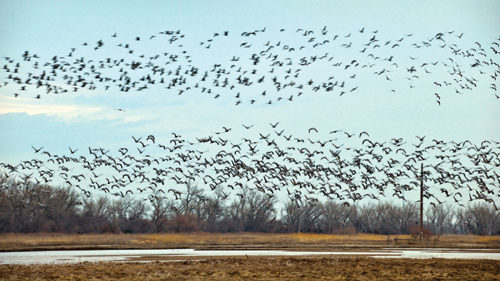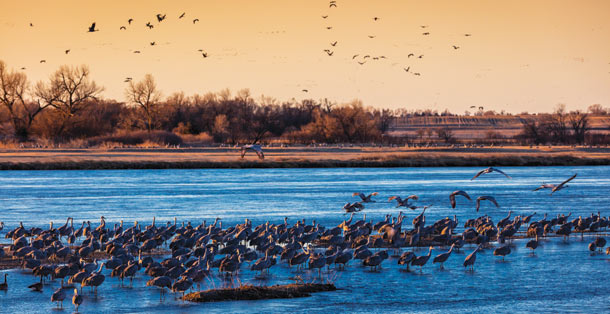
Spring mornings are cold in central Nebraska. You never know what the weather might bring in mid-March. A blizzard could have rolled in the night before, leaving drifts of snow, a rainstorm could be brewing, or freezing temperatures could crystallize from a clear moonless night. It took a Herculean effort for me to rise from the cozy cocoon of blankets at 4:30 a.m. But I had been waiting for this day to come for almost a year. I was awake and eager to witness one of the world’s greatest migrations.
Farmers and ranchers are used to rising early in this agriculture- and livestock-producing state. The first rays of sunshine alert all the living creatures that dawn is approaching. This includes the thousands of sandhill cranes collected along the Platte River Valley. So observers have to covertly prepare to view the cranes from the camouflage of blinds before dawn casts first light.
Who would have thought that one of the world’s greatest migrations happens every spring along a small sliver of habitat in south-central Nebraska? When I think of a “great migration,” Africa first comes to mind, where thousands of wildebeests race across the vast Serengeti annually. Or the Great American West, where millions of stampeding bison once stirred up massive dust clouds along the plains and 19th-century pioneers braved harsh elements as they rolled westward in covered wagons.

But Nebraska is, in fact, host to one of the world’s greatest winged migrations. Eighty percent of the world’s sandhill crane populations migrate through Nebraska during late February, March, and early April. On average, that’s more than 500,000 birds — within a 6-week period.
The sandhill crane stands 4 feet tall with a wingspan that spreads nearly 6 feet across — about the width of a large sofa or a king-size bed. When planning this trip, I thought that must be quite a spectacle to see hundreds of thousands of them, a fleet of feathery sofas flying across the sky to arrive at the same place at the same time every year — a narrow neck of the Central Flyway path, where grayish-brown waves of migrating cranes fill the vast empty gaps between the blue yonder and the dusky patches of earth below along the rainwater basins of Nebraska’s Platte River valley. The “hourglass” expanse (just 15 miles) fills with birds crowding along the muddy shoreline and inlets of the Platte. The shallow braided channels provide a refueling and resting station for the migrating birds in their 5,000-mile journey from wintering grounds in Mexico to breeding grounds in Canada, Alaska, and Siberia.
Every inch of the sandbars becomes covered with cranes seeking protection for the night, where they keep a lookout for predators like eagles or hawks ready to snatch a wounded or lone bird. At sunrise, they fan out in groups to nearby fields filling up mostly on harvest leftovers of waste corn to build up their fat reserves for the journey north.

I was on my way to the Crane Trust Nature and Visitor Center, located along the Big Bend area of the Platte River, to partake in one of their very special sandhill crane blind tours. These are offered mornings and evenings when the cranes leave their protected sandbar resting station — our best chance to see thousands upon thousands of cranes at one time.
Long ago, glaciers scoured the land and created the sandbars. Since many rivers have been dammed up, those natural characteristics have changed. The Crane Trust was created to protect and maintain the river in its most natural state. Conservation of the river and the prairie habitat serves all species of birds that migrate through the Central Flyway path, in addition to the cranes.

Prior to the trip, I purchased Sheila Buff and Richard Day’s Birding for Beginners, which helped especially with recognizing courting rituals such as “dancing” (jumping and executing intricate wing movements), “curtsying,” and offering food or nesting items. It all sounded a bit awkward, like suffering through prom-night antics.
It was still dark at 5:30 a.m. Our guides gave a brief talk on crane blind viewing etiquette. The key points: to be very quiet and as still as possible so as not to alert the slumbering birds to sudden movements and sounds. No camera flashes, no clicking on cellphones, no talking, no sneezing, not even a whisper, and no slurping of hot coffee.

During the brief talk at the Nature and Visitor Center, we learned that if the nonprofit Crane Trust didn’t exist, the habitat would most likely be another cornfield. As it stands currently, 90 percent has never been tilled, and the river remains protected and managed by the trust. That’s very good news for migratory waterfowl. The guide ended the briefing with, “You will be looking at the largest roost in the world.”
We were led single-file out into the dark. After shuffling quietly along a dirt path for 10 minutes, we stood in front of the blind, a small wooden building. I thought about the pioneers who settled in the area. How strange it must have been for them to see thousands of large cranes for the first time.
Once inside, the guide instructed us with hand signals to sit on the benches that ran the length of the back wall. Cups of steaming coffee were offered, and we waited for the first glimmer of sunrise. Hard to believe we were invisible to the thousands of cranes nesting along the river sandbars just a few yards from the small enclosure.

A few photographers collected toward the east side of the blind, prepping close to the windows for sunrise shots. People started standing in coveted full-window spots, jockeying for the best viewing positions. It seemed a bit strange, like waiting for a Broadway play to begin. Wild creatures do not perform on cue like actors, but they do perform according to their evolutionary DNA set in place millennia ago. We were the lucky audience waiting for the show to begin.
Slowly, dawn emerged, a line of light released across the horizon. The sky quickly brightened to orange, peach, mauve, and yellow. Hazy, like a mirage, the sandbars revealed themselves bit by bit. In this haze of dawn, we heard, even before we saw, the fluttering of hundreds upon hundreds of feathers, like a fan set on high, followed by the shrill cries of cranes stirring. In front of us, thousands of sandhill cranes were preparing to lift off. As far as the eye could see along each side of the sandbars, cranes were flapping feathers, some curtsying, and gathering in groups.
The birds took flight in what seemed like a “domino effect” — one right after another, swirling up into the thermals, gathering into formation as they screeched away to forage in the fields for the day. The throaty purring cry of the restless birds was deafening at times. The volume of the collected roaring increased and diminished as flock after flock flew out of sight.

The thrill of the scene and the rush of the moment were spellbinding. I heard a few people exclaim “Wow!” and “That’s amazing!” Caught up in the zeal, I probably said “wow” a number of times too. I looked around at the stunned and smiling faces. Clearly, we were all awestruck. “Wow” just didn’t seem like a good-enough response to such a spectacle. It felt so small for such a big moment in time. I watched the birds stitching their way across the clouds, like a black line of thread pulling against the seam of blue sky.
One guide joked that the month of March was the sandhill crane’s version of Christmas; they had plenty to eat and a place to rest. It was like Christmas for me too — a special gift to see something so extraordinary and to know that long after I’m gone, the migration will continue as it has for thousands of years.
Cranes in Action
Sandhills Cranes in Nebraska. (Video by Nebraska Tourism)
Nebraska’s Great Sandhill Crane Migration (Video by Crane Trust)
To Learn More
Contact the Nebraska Tourism Commission for more information on sandhill crane viewing at VisitNebraska.com.
Visit the Crane Trust at cranetrust.org or the Rowe Sanctuary at rowe.audubon.org to discover more about their sandhill crane programs.
Gigi Ragland has published work in National Geographic Traveler, American Way in-flight magazine, and Denver Life, among others. For more, visit gigiragland.com.
Become a Saturday Evening Post member and enjoy unlimited access. Subscribe now




Comments
Beautiful article! Love the playful nature of the storytelling. Would love to experience this some day. Thank you for publishing!